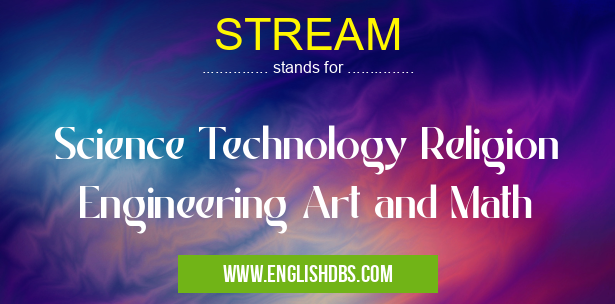What does STREAM mean in ACADEMIC & SCIENCE
STREAM is an acronym that stands for Science, Technology, Religion, Engineering, Art, and Math. It is an educational approach that emphasizes the interconnectedness of these disciplines and aims to foster creativity, critical thinking, and problem-solving skills in students.

STREAM meaning in Academic & Science in Academic & Science
STREAM mostly used in an acronym Academic & Science in Category Academic & Science that means Science Technology Religion Engineering Art and Math
Shorthand: STREAM,
Full Form: Science Technology Religion Engineering Art and Math
For more information of "Science Technology Religion Engineering Art and Math", see the section below.
Key Characteristics of STREAM
- Interdisciplinary: STREAM integrates multiple disciplines, allowing students to explore real-world problems from various perspectives.
- Hands-on Learning: STREAM activities often involve hands-on experiments, projects, and simulations that engage students in active learning.
- Problem-Solving: STREAM encourages students to identify problems, develop solutions, and learn from their experiences.
- Critical Thinking: STREAM fosters critical thinking skills by challenging students to analyze, evaluate, and synthesize information.
- Communication: STREAM emphasizes effective communication skills, both written and oral, to convey ideas and collaborate with others.
Benefits of STREAM Education
- Improved Academic Performance: STREAM education has been shown to improve student performance in science, technology, engineering, and math.
- Increased Creativity: By exposing students to multiple disciplines, STREAM fosters creativity and helps them develop innovative solutions.
- Problem-Solving Skills: STREAM develops problem-solving skills that are essential for success in various fields.
- Global Citizenship: STREAM education prepares students to address global challenges by fostering empathy and understanding of diverse perspectives.
- Career Readiness: STREAM skills are highly valued in today's workforce, preparing students for careers in STEM, business, and other fields.
Essential Questions and Answers on Science Technology Religion Engineering Art and Math in "SCIENCE»SCIENCE"
What is STREAM education?
STREAM education is an interdisciplinary approach to learning that integrates Science, Technology, Religion, Engineering, Art, and Math. It emphasizes hands-on, project-based learning that fosters critical thinking, creativity, and problem-solving skills.
Why is STREAM education important?
STREAM education prepares students for the complex and interconnected world of the 21st century. By integrating different disciplines, it helps them develop a holistic understanding of the world and the skills needed to solve real-world problems.
What are the benefits of STREAM education?
STREAM education has numerous benefits, including:
- Enhanced critical thinking and problem-solving skills
- Improved creativity and innovation
- Deeper understanding of scientific concepts and technological advancements
- Increased appreciation for the interconnections between different disciplines
- Enhanced communication and collaboration skills
- Preparation for STEM-related careers
How is STREAM education different from traditional STEM education?
STREAM education goes beyond the traditional STEM (Science, Technology, Engineering, and Math) disciplines to include Religion and Art. Religion provides a philosophical and ethical framework for understanding the world, while Art fosters creativity, imagination, and expression. Together, these elements create a more comprehensive and well-rounded education.
How can I implement STREAM education in my classroom?
Implementing STREAM education can be done through various methods, such as:
- Project-based learning: Engaging students in hands-on projects that integrate different disciplines
- Cross-curricular activities: Connecting concepts from different subjects through shared lessons or projects
- Field trips and guest speakers: Exposing students to real-world applications of STREAM principles
- STEM-based games and simulations: Using technology to enhance learning and provide immersive experiences
Final Words: STREAM education is an innovative approach that integrates science, technology, religion, engineering, art, and math. By emphasizing interdisciplinary learning, hands-on activities, problem-solving, and critical thinking, STREAM fosters creativity, improves academic performance, and prepares students for success in the 21st century.
STREAM also stands for: |
|
| All stands for STREAM |
